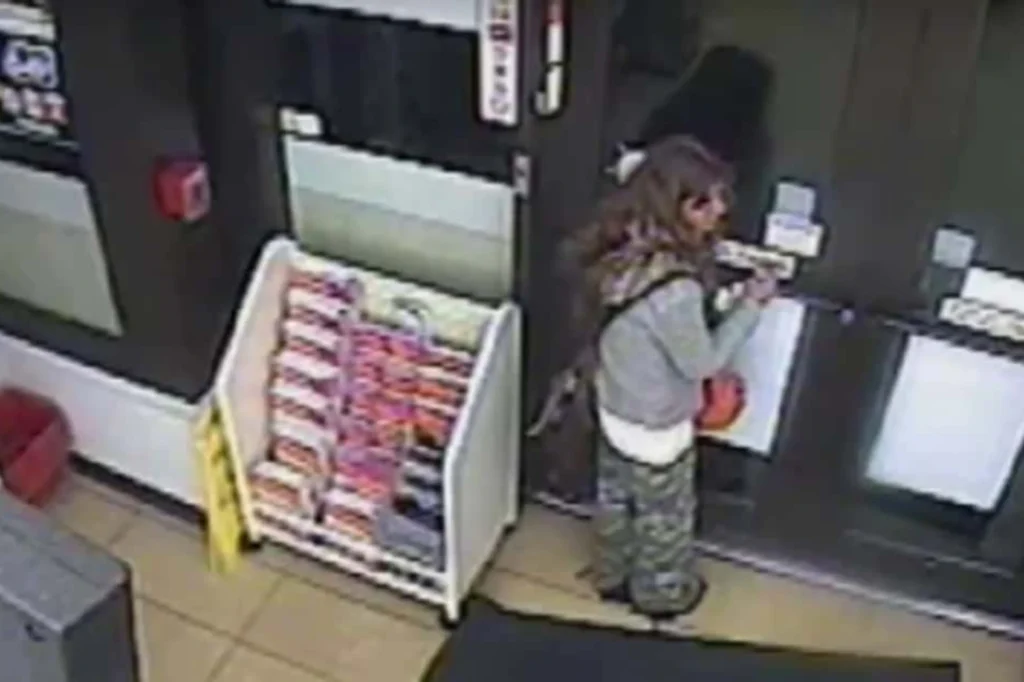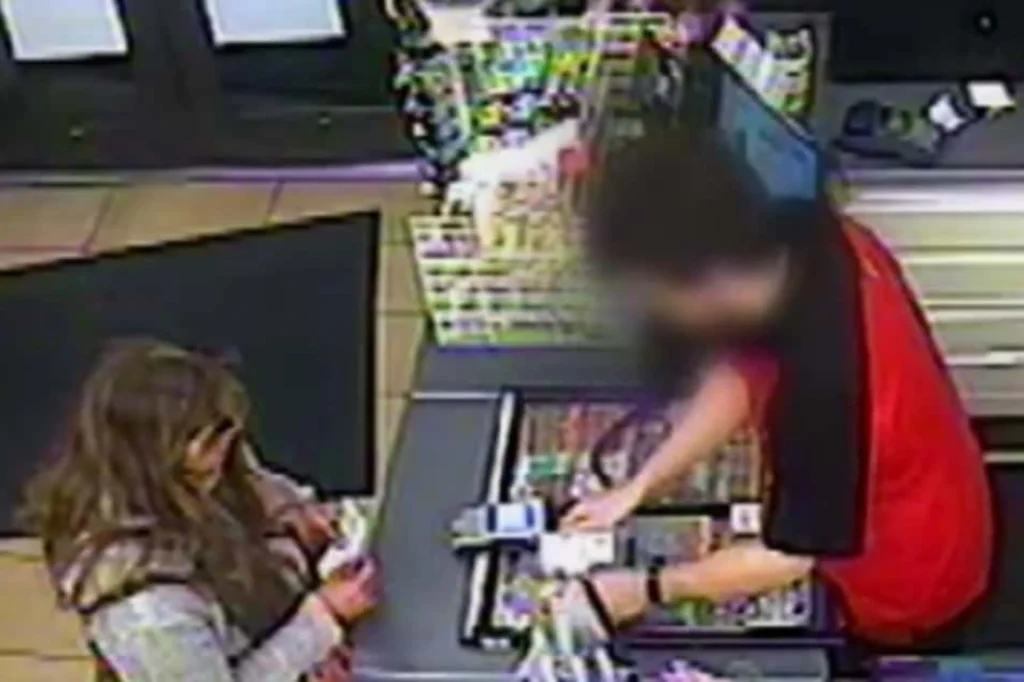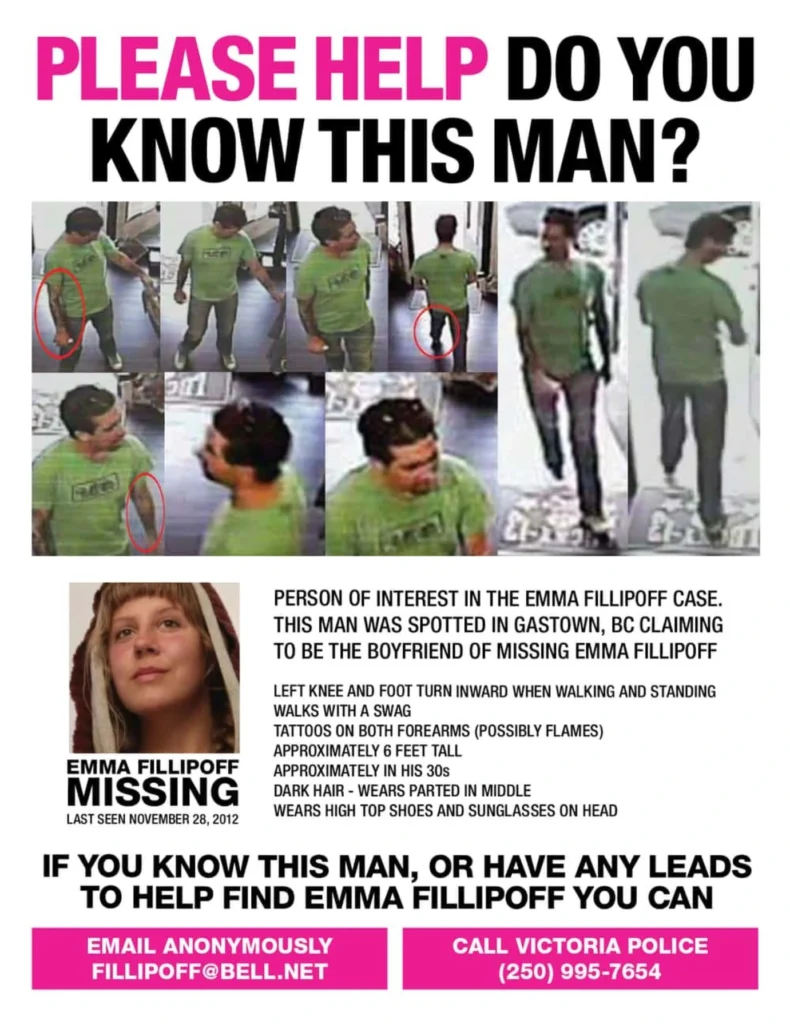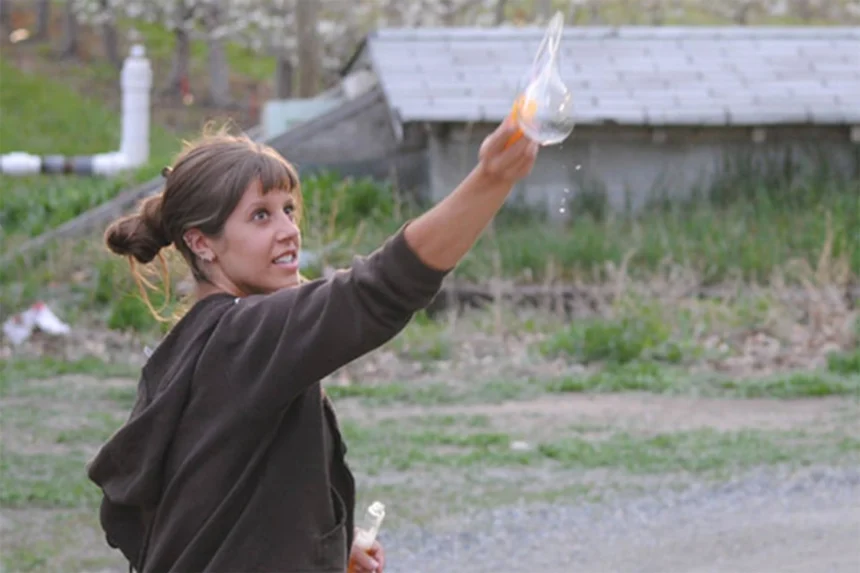On a November evening in 2012, a 26-year-old woman named Emma Fillipoff stood barefoot outside the Empress Hotel in downtown Victoria, British Columbia. She seemed lost, frightened and deeply unsettled. Police officers spent nearly 45 minutes speaking with her but when they left, Emma did too—vanishing into the night. More than a decade later, her disappearance remains a mystery.
Early Life
Emma grew up in Perth, Ontario, a small town where friends and family knew her as a free-spirited, artistic young woman. She painted, wrote poetry and found peace in nature.
But as she grew older, her life became increasingly unstable. She moved often, floated between short-term jobs and sometimes chose to sleep outdoors rather than face the noise of city life.
Her mother, Shelley Fillipoff, has described Emma as “sensitive, gentle, but unsettled.” Emma’s restless lifestyle led her west, eventually to Victoria where she stayed in shelters and sometimes camped in the woods, the Independent reports.
She called her mom frequently during this time, wavering between coming home to Ontario and continuing her unpredictable journey. Each call revealed a little more worry, a little more urgency.
In late November 2012, Shelley decided to fly to Victoria, planning to bring her daughter home. By the time her plane landed, Emma was already gone.
The Last Day

The timeline of Emma’s final known day is both detailed and maddeningly incomplete. Every piece of information raises more questions than answers.
That morning, Emma visited the Chateau Victoria Hotel, where she had occasionally worked in the kitchen. She was seen speaking with staff but told them she wasn’t feeling well. Later, she stopped by the public library, looking tired and unwell.
By afternoon, multiple people spotted Emma walking through the city. One witness claimed she was with an older man. Another saw her twice in the same two-hour span, alone but hurried.
Then, surveillance cameras captured her at a 7-Eleven on Government Street. The footage is unsettling to watch. Emma appears nervous, checking the street before leaving. She buys a prepaid cell phone, then returns shortly after to purchase a $200 prepaid credit card. She clutches the items like she’s preparing for something but doesn’t quite know what.
Around 6:00 p.m., Emma left the Sandy Merriman House, a women’s shelter where she had been staying. She hailed a taxi and asked to be taken to the airport. But only minutes later, she got out—explaining she couldn’t pay the fare, despite having that prepaid card in her pocket.
Not long after, she was seen outside the Empress Hotel, barefoot and clearly distressed. An acquaintance named Dennis Quay spotted her pacing and called police. That call set in motion the last confirmed moments of Emma’s life.
The Abandoned Van

Victoria police arrived at the hotel and spoke with Emma for about 45 minutes. Officers later said she was calm at times but distant, speaking only in short replies.
She refused to put on shoes, despite the cold pavement under her feet. To the officers, she didn’t appear violent or suicidal, so they let her go.
When the officers drove away, Emma walked off into the night. No one has seen her since.
Investigators quickly found Emma’s 1993 red Mazda MPV van parked near the Chateau Victoria Hotel, per Wikipedia. Inside were her clothes, laptop, passport and journals—items anyone planning to travel or disappear would normally take.
Her belongings painted a confusing picture. Some suggested she was preparing to leave Victoria, maybe even to fly home. Others showed she was deeply conflicted, unable to decide what she wanted. Leaving everything behind didn’t fit either version.
Her van became a kind of shrine and seeing all her things left inside made her family believe she never meant to leave for good.
A Tip Six Years Later

For years, the case went cold. Tips came in but none were confirmed. Then, in 2018, a man named William contacted police with a startling claim. He said he picked up Emma on the morning of November 29, 2012—the day after she vanished.
According to him, she was on the side of the road, disoriented and asking for help. He said he drove her to Colwood, a community outside Victoria where she asked to be dropped at a friend’s house.
William admitted he never came forward sooner because he was afraid of being implicated. Police took his claim seriously enough to bring in cadaver dogs and search the area but nothing was found.
The tip gave her mother, Shelley, a brief flicker of hope but without evidence, it became another dead end.
The Heartbreak of Waiting

Since that night in 2012, Shelley Fillipoff has carried her daughter’s story across Canada, pleading for answers. She’s held vigils, posted flyers, spoken to reporters and kept Emma’s name alive.
In an interview, Shelley once reflected on the endless waiting: “I remember thinking that a month was unbelievable and then thinking that six months wasn’t possible.”
She has described Emma’s final weeks as fragile and emotional, filled with indecision and restlessness. To her, Emma seemed both desperate to return home and determined to stay in Victoria.
The Victoria Police Department has kept Emma’s case active, releasing photos and reminders every year near the anniversary of her disappearance. They’ve urged anyone with information to call their non-emergency line or Crime Stoppers.
“There has been an extensive investigation into Emma’s disappearance ever since, but to date investigators have been unsuccessful in determining what may have happened to her,” the department stated.
Her story has spread beyond British Columbia. True crime podcasts, online forums and news outlets in both Canada and the U.S. have covered the case. Each retelling draws in new audiences but the core mystery remains unsolved.
Photos and Final Clues
Investigators also found photographs Emma had taken in the weeks before she vanished. Some were self-portraits, others were of random objects. Police released them, hoping someone might recognize a detail, a location or an object that could lead to answers, according to North Shore News.
None of the photos provided a breakthrough. But they painted a picture of a woman who was searching, observing and perhaps struggling to make sense of her surroundings.
Over the years, people have reported seeing Emma in different places, but none of those sightings were ever verified. One witness said they encountered her near the Inner Harbour where she allegedly told them, “Remember my name.”
Theories swirl online. Some think she was struggling with her mental health and chose to disappear on her own. Others believe someone may have hurt her, since she was in a fragile state and vanished from a busy part of the city. Still, without evidence, every theory remains speculation.
Let’s dig into the legal side of false sightings and fake tips.
False Sightings and Misleading Tips: Could They Be Illegal?
When someone goes missing the clock starts ticking. Police scramble to put the pieces together, families wait by their phones and communities rally with flyers, posts and search parties.
In the middle of all this, every little tip feels like it could be the big one. Someone says, “I saw her at the bus stop!” Another person calls in, “Pretty sure I saw something weird by that old empty house.” Everyone’s holding on to hope. But then, weeks later, the truth drops—it was all made up. None of it was real.
It might sound like a small thing, just one bad lead in a sea of confusion but false sightings and misleading tips don’t just waste time, they can ruin investigations and in many cases, they’re not just unethical. They’re illegal.
The Law in Black and White
In the United States, there are clear laws against knowingly lying to law enforcement. One of the most cited is 18 U.S. Code § 35, which deals with “imparting or conveying false information.” On paper, it looks straightforward: if you knowingly pass along false information about a crime, especially one that threatens public safety, you can face fines of up to $1,000, prison for up to five years or both.
And it doesn’t stop there. Another law, 18 U.S.C. § 1001, makes it a federal crime to knowingly and willfully make false statements to federal authorities. In plain English: if you lie to the FBI, DEA, or any federal investigator, you could be facing years behind bars and some heavy fines.
According to the Department of Justice, these rules exist because “false statements strike at the heart of government integrity.” When lies get tangled up in real investigations, they distort the search for truth and eat away at trust in the justice system.
Not Just a “White Lie”
It’s tempting to imagine these situations as harmless exaggerations—someone thinks they saw something but misremembers. The law doesn’t come down on mistakes made in good faith. If you genuinely thought you saw a person who looked like a missing child and you called it in, that’s not a crime. That’s just being human.
But when someone makes up a sighting on purpose, tells a fake story or gives cops info they know isn’t true, that’s a whole different game. Now it’s not just a waste of time—it’s called obstruction. And yeah, obstruction is taken super seriously.
As one former prosecutor said, “False reports don’t just waste resources. They send investigators chasing shadows while real evidence slips away.”
How False Tips Play Out
Imagine a missing person case in a small town. Volunteers are searching wooded trails, police are following up on phone calls, and investigators are knocking on doors. Then a tip comes in: “I saw her near the gas station yesterday. She was with a tall man in a black hoodie.”
The whole operation shifts. Officers pull security footage from the gas station, interview clerks and spend hours tracking down men in dark hoodies. Days later, it turns out the tipster made it up. Maybe they wanted attention. Maybe they were bored. Whatever the reason while officers wasted time chasing a ghost, the real trail went cold.
That’s the real-world damage of a false report. It eats up manpower, delays progress and drags families through an emotional rollercoaster.
Consequences That Stick
The law takes this seriously. Someone convicted under federal false information statutes could see up to five years in prison. Add in state-level charges—many states have their own false reporting laws—and the penalties can stack up.
Take Texas, for example. Filing a false police report there is a Class B misdemeanor, which can mean up to 180 days in jail and a $2,000 fine. In New York, knowingly reporting false information can be a felony if it involves serious offenses. States vary but the theme is the same: if you deliberately waste law enforcement’s time, expect consequences.
And those consequences aren’t just legal. A conviction for false reporting can stick to someone’s record for life. It can ruin job prospects, especially in professions that depend on trust—teachers, lawyers, medical workers. Immigration status can even be jeopardized for non-citizens.
If you think lying to the police is a shortcut, it’s actually the fastest road to wrecking your future.
Federal Eyes Watching
When false tips are serious enough, federal agencies step in. The FBI has a long history of investigating false reports, especially when they involve threats to public safety. After 9/11, fake tips about terrorism were aggressively prosecuted.
According to justice.gov, “false reports tied to terrorism or national security carry enhanced penalties.” In other words, if you lie about something that could spark panic or endanger lives, judges don’t go easy.
Federal investigators also have tools local police might not—surveillance, advanced forensics, even lie detector tests (though courts debate their accuracy). When a tip is suspected to be false, these tools can quickly reveal the truth.
The Ripple Effect
The damage caused by false reports doesn’t end with investigators. Families of victims often suffer the most. Imagine waiting by the phone for months, desperate for any news about your missing daughter. Then a stranger calls the police and says they saw her in another city. For a moment, hope returns. Maybe she’s alive. Maybe she’s out there.
But when the tip turns out to be fake that fragile hope crashes down again. Families describe it as “being retraumatized,” forced to relive the initial pain of loss each time a false lead dissolves.
Every bad lead is like reopening the wound. Families cling to these tips because they want to believe. False reports don’t just hurt investigations—they crush hearts.
Penalties Can Get Harsher
Not every fake tip gets the same kind of punishment. Like, if you lie about your bike getting stolen, it’s not gonna be treated the same as calling in a fake bomb threat. Big difference. Courts usually look at the situation, why the person lied and how much damage it could cause.
Like, if someone makes up a story about terrorism, a school shooting, or something super serious like that, the punishment usually gets way worse. Judges don’t play around with those kinds of lies because they can freak people out, force big evacuations, and even put totally innocent people at risk.
Probation is sometimes an option but it often comes with conditions like community service, counseling or restitution—paying back the costs of wasted police resources.
State Laws Matter Too
It’s not just federal law that handles false tips. Almost every state has its own statute against false reporting. Some label it “obstruction of justice,” others call it “filing a false police report.”
For example:
- California: False reporting is a misdemeanor punishable by up to six months in jail and a fine.
- Florida: Filing a false report of a crime is a first-degree misdemeanor, carrying up to one year in jail.
- Illinois: If the false report leads to an emergency response, it can be a Class 4 felony with up to three years in prison.
So while the federal penalties grab headlines, state charges often catch offenders first.
The Bigger Picture
False sightings and misleading tips don’t happen in a vacuum, they burn through taxpayer money, eat up limited police resources and chip away at the credibility of real witnesses. When the public learns that tips can be faked, they may become hesitant to believe genuine reports.
Experts stress one rule: if you don’t know, don’t make it up. Reporting what you think you saw, even if it turns out wrong, is fine. But inventing details or passing along lies? That’s not just morally wrong—it’s a crime.
Or, as an investigator said, “We’d rather have ten honest mistakes than one deliberate lie.”
False sightings and misleading tips are more than just noise in a criminal investigation—they can derail entire cases. In the United States, the law is clear: if you knowingly provide false information to authorities, you could be fined, imprisoned or both. Families suffer, police waste time and justice is delayed.
In a world where every second counts during an investigation, the truth really does matter. And when the truth gets buried under lies, everyone loses.




